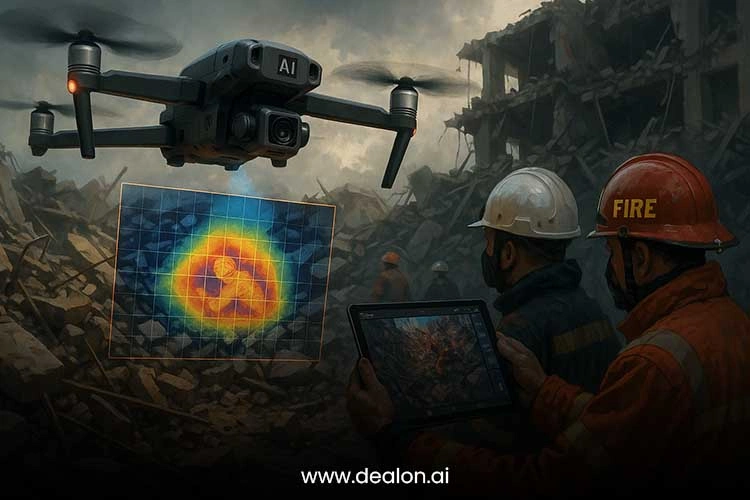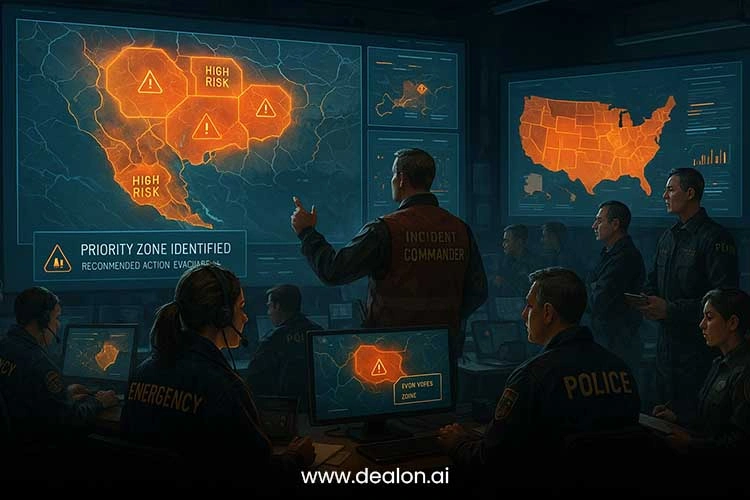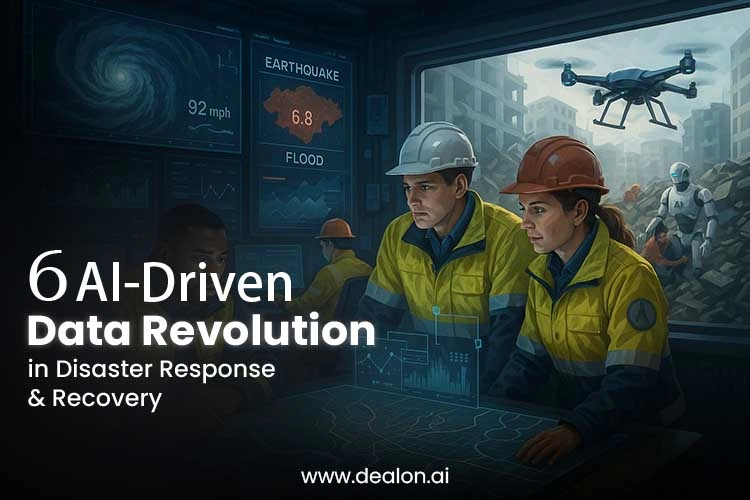The world of today has been facing increased challenges of emergencies such as natural disasters, whereby the requirements of good and responsive measures taken in response to any disasters are very critical. Conventional ways of dealing with disaster response and recovery are not enough, as the frequency and severity of such incidents are increasing. Here comes artificial intelligence (AI), a game changer that is transforming the way we deal with disasters. Whether through predictive analytics or automated decision-making, AI is opening new horizons of efficiency, precision, and speed in how we react to catastrophic events.
The technological capabilities offered by AI are transforming disaster preparedness and response. Its forecasting systems are providing advanced warnings of yet-to-occur catastrophes, and since the advent of AI, a range of tools, including drones and machine learning systems, are streamlining search and rescue operations, optimizing field resource allocation, and increasing the speed of recovery. By incorporating an AI element, there is the possibility of the disaster response teams making more data-driven decisions and ones that would save lives as well as reduce the long-term consequences of such a disaster to the involved communities.
Besides immediate retaliation, AI also has more impacts in terms of response. Use of AI in damage analysis, resource planning, recovery planning, etc, will make sure the provision of aid is adequate and that the process of reconstruction is strategic, cost-effective, and time-bound. With the constant evolution of AI, it is likely to produce even more revolutionary solutions to highly complicated disaster management problems.
In this post, we are going to discuss five new things that AI can revolutionize the management and recovery process of disasters, and how this advanced technology can transform the future of disaster management. As much as it helps improve disaster recovery, AI is also clarifying the way we approach responding to and handling a crisis on a planet that is continuously becoming more turbulent.
Also Read: The Comparison of Traditional AI and Neural Networks for Data
1. Early Disasters Predictive Analytics

The use of AI in disaster response is one of the most revolutionary innovations to date, as it allows predicting natural disasters with a very high degree of accuracy. Using the predictive analytics capabilities, AI can utilize machine learning algorithms to process mountains of different kinds of data, such as historical data, real-time sensor measurements, satellite images, and weather prediction data. AI is capable of evaluating the potential likelihood of the occurrence of events such as earthquakes, hurricanes, floods, and wildfires before they happen by simply acknowledging patterns and correlations in this data. This feature not only complements the response time but also provides a significant edge on disaster readiness.
With the use of AI systems, we can use seismic data to predict the tremors of the earth, keep track of ocean temperatures and wind directions where there might be a hurricane, and even measure the changing moisture levels of the vegetation, which might be an indication of an upcoming wildfire. Such systems are capable of creating warnings well in advance, and they even give warnings days or even weeks in advance before the occurrence of a disaster. With the capability to detect situations early, the government can order timely evacuations, mobilize resources, and warn vulnerable citizens, which can reduce human losses and property damage significantly.
Additionally, AI can do more than predict disasters. Such systems are also able to provide real-time risk estimates, updating their forecasts with the addition of new data. This on-the-go flexibility enables governments, emergency response units, and NGOs to be one step ahead of the curve, creating effective distribution and deployment of assets and specific responses. Ultimately, not only by saving lives, but also by improving the efficiency of responses by emergency services, it is possible to eliminate the pressure on emergency services and have a more coordinated recovery process.
2. Search and rescue drones: AI-Powered

The use of AI-powered drones in the search and rescue mission is transforming the task and offering live intelligence, much needed by emergency experts in destroyed regions. These drones are powerful with features like computer vision, thermal imaging, and the latest sensor technologies, and present unmatched capacities to maneuver and examine the surroundings that are inaccessible to human rescuers. Be it a building that has collapsed, an area that is inaccessible due to a mountain foundation, or an area that has been flooded, AI-powered drones can find people by radar alone, either following a heat signature, a movement, or many other vital signs of people being alive.
In pursuance of AI algorithms, drones can process and analyze the extensive amounts of data (i.e., images and video feeds) they obtain. They can pick out possible survivors with extreme accuracy, as these systems can pick out slight differences in the temperature, body heat, or even the tiniest movements in the wreckage. The autonomous or remote control of the drones makes them very adaptable to ever-changing and risky areas.
Situational awareness for first responders on the ground is also enhanced with the help of AI-powered drones. Transmission of live high-definition feeds to command centers via drones enables rescue teams to determine the most severe areas in which interventions are needed, considerably facilitating the process of response. In addition, AI-powered drones can help to map the location of the disaster, giving a complete picture of the affected territories and identifying the places where the workforce is most in need.
The AI drones enhance rescue missions by improving the speed and accuracy of the search, which means that more people may be retrieved who would have remained unnoticed otherwise. Such drones save lives as well as assist in more effective and efficient management of disasters, as risks and other challenges that usually exist in the execution of post-disaster recovery processes are reduced.
3. Crisis Management-Automation Decision-Making AI: Crisis Management

Quick and efficient decision-making in disaster situations is essential. But the fact is that the response teams are usually dealing with a lot of pressure, and the information is in fragments. The solution to this problem is offered by artificial intelligence (AI), which boosts the crisis management process by automating the decision-making system and offering data-based advice to achieve a timely and effective reaction. It is possible to present AI systems with massive data sets and analyze the data that is coming out of the sensors and drones, satellite images, and even social media feeds.
These sources allow getting an entire and real-time picture of the area of the disaster, and AI algorithms can process this information to produce usable insights. To illustrate, AI should be able to define the degree of damage sustained, identify the people and communities that have been affected, and, in addition, provide the location where resources are most acute. In that way, AI reduces the load on human decision-makers who usually have the problem of fast interpretation of complex data under stressful conditions. The use of AI-based tools helps maximize the use of resources, thus delivering the essential resources like medical equipment, food, and water to the most needed areas.
Moreover, AI can guide the first responders to the affected areas in a way that concentrates on high-risk zones, based on the analysis of real-time data. This minimizes the risk of human error and acts much faster in case of less observation of affected persons or societies that are vulnerable. Finally, the process of automating decision-making through AI can save lives, make the operation of disaster response as efficient as possible, and utilize resources in the most efficient way possible. This kind of crisis management powered by AI changes how disasters are addressed, making confusion something focused and based on facts.
4. Resource Allocation Using AI to Deliver Aid Effectively
One of the most essential parts of the disaster recovery process, and at the same time, the most complicated one, is the efficient distribution of resources. Aid and other relief activities have to be carried out in the aftermath of a disaster within a very short time frame to curtail the suffering, but this is always foiled by various obstacles like infrastructural challenges, displacement of the population, and logistical bottlenecks. In this case, artificial intelligence (AI) controls the distribution of supplies, people, and equipment optimally, according to dynamic data in real-time.
Depending on the situation, the AI algorithms examine several different variables, including population density, the level of damage, and transportation, to respond in the same way as the most effective ways to allocate relief workers. To give an example, AI will help to determine where it is weakest and needs urgent care, thus assisting the relief in groups to know where to go. They are algorithms based on satellite images, GPS coordinates, and even reports on social media that imply high accuracy and data-driven recommendations.
The logistics companies are finding it more and more useful to trace and redirect the transportation of vital supplies using AI. AI is also able to anticipate any possible delays, estimate the most efficient routes, and divide the available transportation means, so that the supplies get to places in time and at the proper destination. This real-time optimisation is to reduce bottlenecks and guarantee that the delivery of the necessary aid to the affected populations does not have unnecessary delays.
Through improved logistics, AI will not only ensure faster delivery of humanitarian aid but also decrease the chances of wasting resources, as well as the use of limited resources where they are most required. Finally, the process of resource allocation is being redefined by the AI-powered response to an emergency, as relief delivery is now much faster, more efficient, more correct, and effective.
5. Machine Learning in the Assessment of and Planning of Damage Recovery
Post-disaster, proper and efficient recovery and rebuilding require proper and prompt damage estimation. The conventional way in which this is done is labor-intensive and time-consuming, and usually involves physically surveying the affected areas by the teams, which may spend days or even weeks doing so. Machine learning, though, and computer vision are radically changing this method by speeding it up and making it more accurate based on thousands of digitized data points.
With capabilities of processing a variety of image data (aerial imagery, satellite data, and even social media posts), AI systems can help determine the level of destruction in real-time. The machine learning algorithm could use visual data – drones, satellites, etc. – and identify structural damage, the condition of infrastructure, and the effect on the natural resources. Such systems can mark out the worst-affected areas automatically before giving recovery teams well-structured and data-sensitive maps of the areas that are damaged.
This assists in the process of damage evaluation, making it much faster to deliver, and will be used by human beings in processing and interpreting the data manually. Having such AI-enhanced insights, recovery teams will be able to sort the priorities that immediate attention should be paid to, thereby guaranteeing that aid and resources are distributed effectively. Furthermore, the AI can process trends over a period to determine how the recovery efforts might unfold to facilitate optimal distribution of resources during the rebuilding stage.
Incorporation into damage assessment tools to provide disaster recovery that is more strategic, precise, and adaptable by offsetting machine learning. Such a data-driven approach not only accelerates the homecoming but also contributes to the deployment of all resources in the best and most efficient manner that ensures the acceleration of the overall restoration of communities and infrastructure.
6. Artificial Intelligence in Post-Disaster MH Support
The consequences of a disaster in terms of emotion and psychological well-being to the victim communities can be highly destructive. There is a growing use of AI in solving the mental health issue that follows traumatic experiences. Such AI-based technology is aiding in the detection of a person with a risk of experiencing a mental health crisis, such as those known to have post-traumatic stress disorder (PTSD), anxiety, or depression.
The AI algorithms will be able to examine a whole range of pieces of data, including social media correspondence, text messages, and mobile app activity, to identify a hint of discomfort. Observing patterns in the language or behavior, such systems can alert the problematic folks who might need immediate mental health assistance, so that the response can be commenced soon. Virtual counselors and AI chatbots based on NLP can also be used to immediately support those who have been affected and provide a safe place where they can freely share their feelings and lower the sense of stigma when seeking help.
Moreover, through teletherapy, as well as in-person consultations, AI-based systems can pair people with suitable mental health experts. Through the analysis of the unique set of symptoms and needs, AI can contribute to the fact that people are introduced to the appropriate care as fast as possible, which contributes to the overall improvement of access to mental health services.
The introduction of the AI element into post-disaster mental health assistance also allows for greater scale and efficiency of cognitive support, eliminating stigma around seeking treatment, and bringing it where it is most needed in the first critical moments. The use of this AI in emotional recovery not only helps the communities recover their emotions but also leads to long-term resilience of disaster-affected communities.
Conclusion
To sum up, there is no doubt that artificial intelligence is changing the way people respond to a disaster and the process of recovery after such situations, offering solutions to the problems that are considered the most complicated in crisis management. Early warning systems of AI-driven predictive analytics that enable early warning of natural calamities, to high-tech drones operating with AI, and advancing search and rescue programs, AI is changing the efficiency and effectiveness of disaster management systems drastically. Automating the decision-making processes and aligning resource distribution with the needs of the day, AI guarantees that no second is wasted so that there is a lesser chance of committing mistakes and delays in case of critical situations.
Furthermore, machine learning is transforming the process of damage analysis and recovery, which allows making swift, data-based assessments of the impact and developing strategic planning in damage recovery resource allocation. The capacity of AI (processing and analyzing large amounts of data in real-time) will make recovery activities well-coordinated, targeted, and effective, saving lives and preventing the long-term impact of disasters.
The use of AI technologies in the rescue system will undoubtedly become even more advanced as AI technologies develop further, and they will have even more potential to save people, minimize property losses, and create stronger communities. AI, machine learning, and data-driven decision-making are where disaster management is headed as a way of combining technological advancement with human experience to promote faster disaster recovery, more knowledgeable disaster response, and sturdier and more resilient communities.

